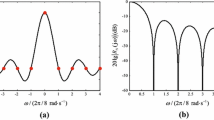Abstract
In this paper, the five-percent maximum overshoot design of uniformly damped binomial filters (transfer functions) is introduced. First, the Butterworth filter response is represented as a damped binomial filter response. To extend the maximum overshoot response of the second-order Butterworth to higher orders, the binomial theorem is extended to the uniformly damped binomial theorem. It is shown that the five-percent uniformly damped binomial filter is a compromise between the Butterworth filter and the standard binomial filter, with respect to the filter approximation problem in the time and frequency domain. Finally, this paper concludes that in applications of interest, such as step-tracking, where both strong filtering and a fast, smooth transient response with negligible overshoot are desired, the response of the normalized five-percent uniformly damped binomial form is a candidate replacement for both the Butterworth and standard binomial filter forms.












Similar content being viewed by others
References
A. Acharya, S. Das, I. Pan, S. Das, Extending the concept of analog Butterworth filter for fractional order systems. Signal Process. 94, 409–420 (2014). https://doi.org/10.1016/j.sigpro.2013.07.012
Y. Bavafa-Toosi, Fundamental limitations, in Introduction to Linear Control Systems, ed. by Y. Bavafa-Toosi, (Academic Press, 2019), pp. 847–974. https://doi.org/10.1016/B978-0-12-812748-3.00010-0
S. Bennett, A History of Control Engineering, 1930–1955. IET (1993)
T. Bensouici, A. Charef, A. Imen, A simple design of fractional delay fir filter based on binomial series expansion theory. Circuits Syst. Signal Process. 38(7), 3356–3369 (2019). https://doi.org/10.1007/s00034-018-1000-8
W. Bolton, System response, in Instrumentation and Control Systems (Third Edition), (Newnes, 2021), pp. 227–256. https://doi.org/10.1016/B978-0-12-823471-6.00010-1
S. Butterworth, On the theory of filter amplifiers. Wireless Eng. 7(6), 536–541 (1930)
B. Carter, R. Mancini, Fast, simple filter design in Op Amps for Everyone (Fifth Edition), (Newnes, 2018), pp. 259–280. https://doi.org/10.1016/B978-0-12-811648-7.00017-0
A.G. Dempster, N.P. Murphy, Lagrange interpolator filters and binomial windows. Signal Process. 76(1), 81–91 (1999). https://doi.org/10.1016/S0165-1684(98)00248-5
A.G. Dempster, N.P. Murphy, The binomial window: heuristics and metrics. Signal Process. 80(12), 2641–2645 (2000). https://doi.org/10.1016/S0165-1684(00)00146-8
K.G. Derpanis, Overview of Binomial Filters (2005)
F. Dessen, Optimizing order to minimize low-pass filter lag. Circuits Syst. Signal Process. 38(2), 481–497 (2019). https://doi.org/10.1007/s00034-018-0877-6
G. Ellis (Ed.), Filters in Control Systems. (Butterworth-Heinemann, Boston , 2012), pp. 165–183. https://doi.org/10.1016/B978-0-12-385920-4.00009-6
M.S. Fadali, A. Visioli, Digital Control Engineering. Elsevier (2020). https://doi.org/10.1016/C2017-0-01563-X
T. Hägglund, A unified discussion on signal filtering in PID control. Control. Eng. Pract. 21(8), 994–1006 (2013). https://doi.org/10.1016/j.conengprac.2013.03.012
D. Hazony, Time-limited and band-limited environment: signals and systems. Circuits Syst. Signal Process. 16(2), 247–270 (1997). https://doi.org/10.1007/BF01183278
V. Hernandez, G.W. Irwin, G.W. Irwin, Algorithms and Architectures for Real-Time Control 2000. Elsevier Science (2000)
W. Jung, Standard responses, in Op Amp Applications Handbook, (Newnes, Burlington, 2005), pp. 325–348. https://doi.org/10.1016/B978-075067844-5/50137-5
H. Kennedy, Recursive digital filters with tunable lag and lead characteristics for proportional-differential control. IEEE Trans. Control Syst. Technol. 23(6), 2369–2374 (2015). https://doi.org/10.1109/TCST.2015.2399436
E. Kupče, Binomial filters. in Data Handling in Science and Technology, Signal Treatment and Signal Analysis in NMR, vol. 18, ed. by D.N. Rutledge. (Elsevier, 1996), pp. 145–163. https://doi.org/10.1016/S0922-3487(96)80044-X
C. Lastre-Domínguez, Y.S. Shmaliy, O. Ibarra-Manzano, J. Munoz-Minjares, L.J. Morales-Mendoza, ECG Signal Denoising and Features Extraction Using Unbiased FIR Smoothing. BioMed Res. Int. 2019, e2608547 (2019)
W.S. Levine, Signal processing for control, in Handbook of Signal Processing Systems,, ed. by S.S. Bhattacharyya, E.F. Deprettere, R. Leupers, J. Takala. (Springer, New York, 2013), pp. 261–279. https://doi.org/10.1007/978-1-4614-6859-2_9
V. Litovski, Electronic Filters: Theory, Numerical Recipes, and Design Practice Based on the RM Software. Lecture Notes In Electrical Engineering Vol. 596. Springer (2019)
P. Marchand, L. Marmet, Binomial smoothing filter: a way to avoid some pitfalls of least-squares polynomial smoothing. Rev. Sci. Instrum. 54(8), 1034–1041 (1983). https://doi.org/10.1063/1.1137498
R. Oldenburger (ed.), Optimal and Self-Optimizing Control (Press, M.I.T, 1966)
A.V. Oppenheim, R.W. Schafer, Discrete-Time Signal Processing, 3; international edition. Pearson Education (2014)
L.D. Paarmann, Design and Analysis of Analog Filters: A Signal Processing Perspective, Series in Engineering and Computer Science, vol. 617, first edn. (Springer, 2001)
I. Pitas, A.N. Venetsanopoulos, Nonlinear Digital Filters: Principles and Applications. The Springer International Series in Engineering and Computer Science. Springer US (1990). https://doi.org/10.1007/978-1-4757-6017-0
D.L. Porte, Replace discrete lowpass filters with zero design effort, two item BoM and no surprises. in Analog Circuit Design Ed. by B. Dobkin, J. Hamburger. (Newnes, Oxford, 2015), pp. 1009–1010. https://doi.org/10.1016/B978-0-12-800001-4.00470-1
W.B. Ribbens, The systems approach to control and instrumentation, in Understanding Automotive Electronics (Seventh Edition), (Butterworth-Heinemann, Oxford, 2013), pp. 1–49. https://doi.org/10.1016/B978-0-08-097097-4.00001-1
M.M. Seron, J.H. Braslavsky, G.C. Goodwin, Fundamental Limitations in Filtering and Control. Communications and Control Engineering. (Springer, London, 1997). https://doi.org/10.1007/978-1-4471-0965-5
O. Somefun, SFF. Github (2021)
M.T. Thompson, Analog low-pass filters, in Intuitive Analog Circuit Design (Second Edition), Ed. by M.T. Thompson. (Newnes, Boston, 2014), pp. 531–583. https://doi.org/10.1016/B978-0-12-405866-8.00014-0
C.L. Tipton, Man-machine system equalization determination and its implementation, in Proceedings of the Third Conference Held at University of Southern California. Clearinghouse for Federal Scientific and Technical Information, (Los Angeles, California, 1967), pp. 441–456
D. Topisirović, V. Litovski, M.A. Stošović, Unified theory and state-variable implementation of critical-monotonic all-pole filters. Int. J. Circuit Theory Appl. 43(4), 502–515 (2015). https://doi.org/10.1002/cta.1956
C.C. Tseng, S.L. Lee, Closed-form designs of digital fractional order Butterworth filters using discrete transforms. Signal Process. 137, 80–97 (2017). https://doi.org/10.1016/j.sigpro.2017.01.015
W. Van Drongelen, Filters: digital filters, in Signal Processing for Neuroscientists (Second Edition), (Academic Press, 2018), pp. 345–359. https://doi.org/10.1016/B978-0-12-810482-8.00018-7
Funding
This work was not funded by any organization.
Author information
Authors and Affiliations
Corresponding author
Ethics declarations
Conflict of interest
The authors declare that they have no conflict of interest.
Code availability
The code used to develop this article can be found on Github https://github.com/somefunagba/sff.
Additional information
Publisher's Note
Springer Nature remains neutral with regard to jurisdictional claims in published maps and institutional affiliations.
Rights and permissions
About this article
Cite this article
Somefun, O., Akingbade, K. & Dahunsi, F. Uniformly Damped Binomial Filters: Five-percent Maximum Overshoot Optimal Response Design. Circuits Syst Signal Process 41, 3282–3305 (2022). https://doi.org/10.1007/s00034-021-01931-2
Received:
Revised:
Accepted:
Published:
Issue Date:
DOI: https://doi.org/10.1007/s00034-021-01931-2




